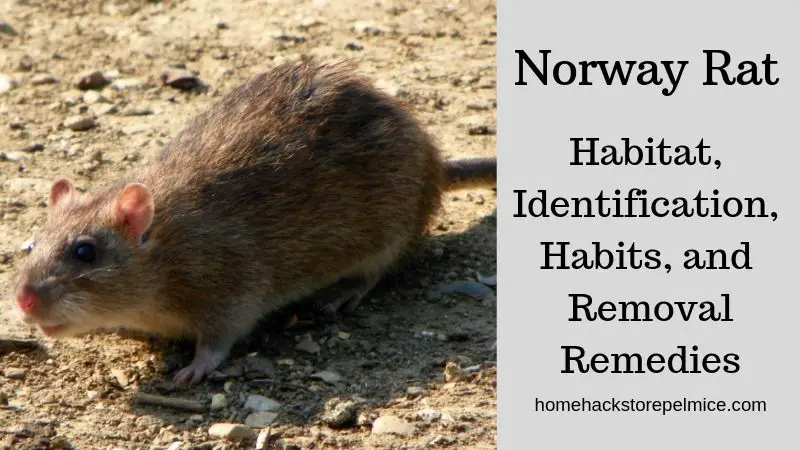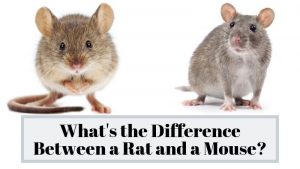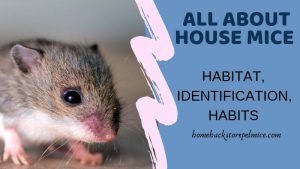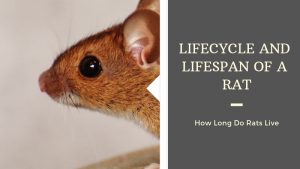The Norway rat is a rat with many names. According to the system of Binomial nomenclature, the Norway rat’s scientific name is Rattus Norvegicus. Other than this formal name, the Norway rat is often known by the different locations it is commonly found in– such as wharf or street rat.
Sometimes it is known by the name of cities and countries it is commonly found in – examples are Hanover rat and Parisian rat. The most common names are Norwegian rat, or Norwegian sewer rat. And most commonly it is known by its color—brown rat or gray rat.
Did you know that though it is called the Norwegian rat, it did not originate from Norway? It was originally called the Hanover rat. In the late 18th century, the English started to call it by the name Norwegian rat as they believed that these common rats had migrated to England from Norwegian ships.
In the 20th century, naturalists discovered that these rats did not originate from Norway, but originally hail from Central Asia and China. Today, it has multiplied to become one of the most common rodents found in the world along with the House Mouse and the Roof Rat.
How do I identify Norway rats?
The Norway rat is a heavy-set rodent with a stocky body. It has a blunt nose, small eyes, and little ears. It has a brownish-red body with sparsely scattered black hair and a greyish white underbelly. Its entire body is usually covered with a short, dense and coarse fur. The Norway rat weighs approximately 12-16 oz. It has a body length of 6-8 inches long. It has a scaly and rough tail. Its length is shorter than the length of the body and head combined, and scale-like. As per Science Direct, it has a tail that is about 85% of the length of the body.
Norway rat vs. roof rat
The Norway rat is often mistaken as the roof rat due to similarities in their appearance. How can you tell a Norway rat from roof rat? According to the Alameda County Department of Environmental Health, Norway rat size is bigger than roof rats. Norway rats are also heavier vs. roof rats. Although These rats are brawnier than the roof rats, they have smaller eyes and ears as compared to the roof rat.
The usual method of identifying the difference between a Norway rat and Roof rat is pulling their tail back over the body. The Roof rat’s tail will reach up to its nose. But, the tail of the Norway rat will not reach beyond the ears.
Are Norway rats an invasive species?
Norway rats are an invasive species. According to research conducted by Columbia University, Norway rats entered Norway and Europe around 1500 AD from China and Central Asia. They were later accidentally introduced into North America by immigrants who arrived on ships from Europe.
As a result of this unintentional distribution, these brown rats are now found across the world. They frequently have a negative effect on native species. They are responsible for not only a decrease in population but also the extinction of several species of animals, birds, amphibians, and reptiles, especially on small islands.
The lifespan of Norway rat & Reproduction
The average lifespan of wild Norway rats is approximately two to three years. They may live up to four or five years under human care.
Norwegian sewer rats are polygynandrous. Norway female rats and male rats within the same group have numerous partners. Research conducted by Smithsonian’s National Zoo & Conservation Biology Institute states that female brown rats become sexually active when they are four months old while males reach sexual maturity at the age of three months. The most common breeding season is during warmer spring and summer. The gestation period is approximately 22 to 24 days. Females usually have approximately 7 newborns per litter and can give birth to about 6-8 litters per year. And unbelievably, they can mate as fast as 18 hours after giving birth. They are prolific breeders and Norway rats can aggressively multiply their population size.
Habitat—where do Norway rat live?
Originally, Norway rats were known to live mainly in woods and forests. However, with increasing human interaction they now prefer to live within close proximity of human beings.
In today’s time, the Norway rat habitat is very diverse. Summit County Public Health has provided in-depth details about their habitat. They are known to live not just in fields, farms, and forests but also near human settlements in cities and suburbs.
On farms, they prefer to live near grain-storage rooms, silos, livestock barns, and kennels.
In cities and towns, they live around sewers, gutters, basements, storehouses, slaughter homes, grocery stores, shipping docks, homes, and buildings. Norway rat habitat is found in any location that provides them with adequate food, water, and shelter. Norway rats burrow under buildings creating hollows for storing food and for nesting purposes.
Food Habits – What do Norway rat like to eat?
Norway rats will eat practically every variety of food that is available to them. They are known to have a nutritious and balanced diet. They are smart eaters and prefer to eat fresh and healthy food instead of contaminated, old, or stale food.
Norway rats are incredible foragers and can easily find food using their superior sense of smell and touch. Norway rat diet consists of plant products like cereal grains, vegetables, nuts and fruits and also non-plant products like meats and fish. Norwegian rats eat about 28-30 grams of food every day and require about 20 to 30 ml of water every day. They need more water when their diet consists of dry foods and they have lesser water requirement when they feed on moist foods.
According to the University of Michigan’s Museum of Zoology, some Norway rats living near the sea can also catch fish with their paws. They also eat small chicks, birds, mice, and little lizards.
Norway rat predators:
There are several predators of the gray rat. Norway rat predators include:
- Carnivorous birds like owls and eagles
- Mammals like foxes, wolves, cats, and dogs
- Reptiles like snakes and lizards.
Since Norway rats are considered to be pests in most countries, they are widely killed by humans also.
Behavior Habits– Are Norway rats aggressive?
Norway rats are mostly nocturnal. They increase their activity around dusk. Norway rats burrow, scrounge for food, and build their nests after dark. They are also considered to be color-blind. However, they have an acute strength of smell and touch. They are can easily feel extremely minute vibrations on the ground. They use their paws and whiskers to sense their way through complete darkness.
As per BioKids website, Norway rats communicate in different ways. They use sounds and different postures to express their mood and intention. They use visual, acoustic, tactile, and chemical communication channels.
A unique Norway rat characteristic is that they are averse to all things new. They will avoid everything new including food.
They are very good swimmers and are able to survive in sewers, gutters and in areas near water. Their excellent swimming skills have also earned them the tag of “water rats.” They can even enter buildings through toilets and pipelines. Norway rats can climb but they are not great climbers. Due to their heavy-set bodies, they are not swift at climbing.
Brown rats are good learners and have a good memory as well. They are easily able to navigate around a complex network of sewers and burrows. Researchers at North Carolina Forestry opine that the Norwegian rat even remembers the location of pathways, environment, shelter, dangers, food, and water.
Norway rats are usually very shy and avoid any interaction in the presence of humans. But, Norway rats can sometimes be aggressive in behavior. There have even been instances of Norway rats attacking infant human beings. Norway rats may even bite humans.
Signs of Norway mouse infestation
Norway rat infestation can be identified using:
- Droppings:
Norway rat droppings are different from other rodents. Their feces droppings are typically glistening black in color but may differ with variation in diet. Almeda County Vector Control states that Norway rat droppings are oval-shaped like dried raisins or capsules and have blunt endings. The size of their droppings is approximately 1/4 to 1/2 inch in length.
- Track marks:
They leave behind tracks of their hind foot which measures approximately to 3/4-1 inch. They also leave a drag mark of their tail as it drags between their feet. By lightly powdering suspicious areas with flour or unscented baby powder, is sure to show drag marks typical to Norway rats.
- Smudge marks:
Smudge marks are caused by oil and dirt on the Norway rats’ fur. Norway rat rub marks are found on pipes, beams, and support pillar.
- Urine:
Norway rat urine is fluorescent. Both dry, as well as wet urine remains, will illuminate under ultraviolet light.
- Gnawing signs:
Fresh gnawing marks left by these rats are usually rough, while older marks are smooth and greasy.
- Burrows:
Their burrows are usually found along building foundations, or beneath garbage, rubbish and plant undergrowth.
Damage caused by the Norway rat
The City of San Francisco Integrated Pest Management Guidelines evidently affirms that Norway rats cause damage to crops in fields before harvestation. Stored grain stock may also be contaminated by their urine or feces. They may also damage boxes, containers and packaging materials with their sharp teeth.
Norway rats are often known to have caused structural damage to buildings because of their gnawing and deep burrowing. Their burrowing and gnawing has resulted in the weakening of building foundations and support slabs, railroad tracks, and even damage water canals. Norway Rats may gnaw through wires, pipelines, insulation, and cables permanently rendering them useless.
A lot of plantations, new tree sapling, and recently transplanted trees are damaged due to the burrowing of the Norway rat.
Hazards of Norway rat in the house—do Norway rats spread diseases?
Norway rats transmit diseases not just to livestock and pets, but also to humans. Diseases like leptospirosis, rat bite fever, murine typhus, salmonellosis, and trichinosis are spread by Norway rats. According to the CDC, Norway rats may also lead to Hemorrhagic Fever with Renal Syndrome. Occasionally, Norway rats may even cause the dreaded plague though roof rats are a more common cause of it.
Winning the battle against the Norway rat – How to control Norway rats?
Norway rats multiply and reproduce very rapidly. Early detection and prevention is the key to keeping these critters away from your home. It is extremely important to be proactive to successfully control Norway rat population. Some steps that help in preventing their infestation are:
- Firewood should be stored away from the home structure and firewood debris should be cleaned regularly.
- Prevent entry of Norway rats by sealing holes and entry points with steel wool.
- Reduce the availability of water by repairing leaking pipes and removing dampness from attics and basements.
- Reduce the availability of food sources by using well-sealed food containers
- Garbage cans and trash cans should also be properly closed.
- Improve sanitation and hygiene in your neighborhood to keep rodents including Norwegian rats from breeding successfully.
- Regular cleaning of landfills, gutters, and sewers also helps to keep Norway rats away from your area.
Traps and Repellents that work against Norway Rat
The most common method of getting rid of Norway rats is the use of Snap Traps and electronic traps. The snap trap is most commonly used for removing Norway rats. They are easy to use and also affordable.
In recent times, electronic traps are gaining popularity as an easy method of removing these rats. Though they may be a little bit expensive, it is safer to use if you have kids and pets around.
Even weatherproof bait blocks are quite effective in controlling Norway rats. Since brown rats are comparatively larger in size, glue pads or glue boards are not effective on them.
Wrapping Up
These innocent-looking cute rodents can lead to severe damage to your home and property. With a rapid ability to reproduce, the secret to winning the battle against Norway rats is better sanitation, eliminating their nests and burrows, and rat-proofing your building.




